Andrew Cartmel's Blog
April 11, 2021
Casino Royale by Fleming, Wade & Purvis and Haggis
 I saw Casino Royale, the first Daniel Craig Bond, when it came out in 2006.
I saw Casino Royale, the first Daniel Craig Bond, when it came out in 2006.I remembered it as a terrific movie.
And I was right. Watching it again for our podcast, I confirmed that it is indeed a terrific movie.
But only after Vesper Lynd (Eva Green) sits down with Bond on a fast moving train...
What I'd forgotten was that for a good hour or so before that, Casino Royale is so dull that it makes me want to pack in watching it and go and do something else.
It suffers from that familiar, pointless, action film dullness that comes from scenes stuffed with fast moving, violent incident which fails to engage the viewer.
 It doesn't engage because we don't yet care about the characters and we aren't hooked by a strong story — in Bond movies the stories are seldom strong, in any case.
It doesn't engage because we don't yet care about the characters and we aren't hooked by a strong story — in Bond movies the stories are seldom strong, in any case.Daniel Craig does his best, and he makes a great 007. Certainly the best since Sean Connery.
But he's up against a vast avalanche of perfunctory mayhem (though I did quite like the scene with the cobra and the mongoose) in which he inflicts untold harm on innocent bystanders as much as the villains.
 All this culminating in an ill judged sequence where he pursues a bomb maker into an African embassy in Madagascar.
All this culminating in an ill judged sequence where he pursues a bomb maker into an African embassy in Madagascar.Seeing an Aryan hunk of a superhero smash his way through a series of African bad guys made for some uncomfortable viewing.
Admittedly, prior to all this there is a cool little introductory section (shot in black and white) summarising Bond's origin story as an assassin, with some excellent elliptical dialogue about how you become hardened to killing.
 But Daniel Craig'a abilities as a leading man — as Bond — only really begin to get traction once he's paired off with the mockingly enticing Eva Green on that aforementioned fast moving train.
But Daniel Craig'a abilities as a leading man — as Bond — only really begin to get traction once he's paired off with the mockingly enticing Eva Green on that aforementioned fast moving train.
In this respect Casino Royale is very similar to View to a Kill, which also had a tedious and dispensable opening section. And which also only really got started when 007 was paired off with the main Bond girl. In that case Roger Moore with the engaging Tanya Roberts playing a feisty seismologist.
Anyway, Casino Royale is great once Eva Green is on board ("I'm the money") and we're in the section of the movie that bears some resemblance to Ian Fleming's original, though relocated from the Riviera to Montenegro.
 The movie still departs wildly from Fleming, of course. But from this point on it is firm, assured and entertaining and culminates in a great sequence in a sinking house in Venice.
The movie still departs wildly from Fleming, of course. But from this point on it is firm, assured and entertaining and culminates in a great sequence in a sinking house in Venice.The movie is directed by Martin Campbell (Goldeneye, Reilly Ace of Spies, Edge of Darkness).
Judi Dench is very sensibly retained as M, and the script is by Robert Wade & Neal Purivs and Paul Haggis (a Canadian writer who won an Oscar for Million Dollar Baby).
 The villain is Mads Mikkelsen whom I think is a terrific actor but who is wasted here .
The villain is Mads Mikkelsen whom I think is a terrific actor but who is wasted here .So a shaky start, but Casino Royale ushers in a splendid new era for the Bond movies.
Oh yeah, great title sequence, too.
(Image credits: IMDB.)
February 22, 2021
The Long Goodbye by Chandler, Altman & Brackett
 Raymond Chandler's The Long Goodbye is his next-to-last Philip Marlowe detective story.
Raymond Chandler's The Long Goodbye is his next-to-last Philip Marlowe detective story. And it is considered one of his weakest novels. But I didn't know that when I first read it as a teenager...
And I found it dark, compelling and powerful.
Robert Altman's movie adaptation, scripted by Leigh Brackett, is wayward and whimsical and, at the time of its release (1973), had Chandler purists up in arms..
Altman recalls, "A lot of heat came down from people who said, 'That's not Raymond Chandler'." *
But I loved this movie when I saw it in 1973 and I love it just as much, perhaps even more, now.
 It represents Altman and his leading man Elliot Gould's conception of Philip Marlowe, private eye and urban knight errant, defender of the vulnerable and enemy of the wicked...
It represents Altman and his leading man Elliot Gould's conception of Philip Marlowe, private eye and urban knight errant, defender of the vulnerable and enemy of the wicked...But in their irreverent take, Marlowe is a guy who can't even get his cat to eat her dinner.
And she won't be fooled when he tries to con her by putting another brand of cat food into an empty tin of her favourite...
And so she promptly abandons her owner. (Leaving through a piece of cardboard in the window labelled El Porto del Gatto.)
 This is how the movie begins, and not surprisingly it was not the brainchild of screenwriter Leigh Brackett. "The cat... is all Robert Altman," says Alan Rudolph.
This is how the movie begins, and not surprisingly it was not the brainchild of screenwriter Leigh Brackett. "The cat... is all Robert Altman," says Alan Rudolph.
But it's a great sequence. And it features an amazingly well trained cat.
Amazing cat aside, the movie begins with Marlowe being approached by an old friend who is in trouble, Terry Lennox (Jim Bouton).
He wants Marlowe to drive him across the border into Tijuana. No questions asked.
Loyal to the death, Marlowe would never turn away a friend in need. So he does exactly that.
 But on Marlowe's return to LA the cops come knocking, and tell him Terry was fleeing because he'd murdered his wife.
But on Marlowe's return to LA the cops come knocking, and tell him Terry was fleeing because he'd murdered his wife.Marlowe doesn't believe his friend is guilty, and refuses to cooperate. The ensuing sequence, with the police arresting Marlowe and grilling him, is played for silly, surrealistic laughs.
But others parts of the film are played powerfully straight— like the story of doomed writer Roger Wade (Sterling Hayden) and his long suffering wife Eileen (Nina van Pallandt), which has considerable reality and power, rooted by van Pallandt's touching performance.
 This is virtually Nina van Pallandt's film debut (before this she was half of the folk singing duo, Nina and Frederick). But she is a tender and commanding presence, and one of the best things in the movie.
This is virtually Nina van Pallandt's film debut (before this she was half of the folk singing duo, Nina and Frederick). But she is a tender and commanding presence, and one of the best things in the movie.And she was entirely Altman's idea — he spotted her on a talk show and thought, "That's Marlowe's blonde."
Altman always was a genius at casting. And he was the actor's director par excellence.
Looking back years later on van Pallandt's performance in the film, Altman reflects, "She's terrific."
 She certainly is. Gould clowns throughout this movie, but he dials down the clowning and really turns up the charm in his scenes with van Pallandt.
She certainly is. Gould clowns throughout this movie, but he dials down the clowning and really turns up the charm in his scenes with van Pallandt. (And he can be very charming, with a great face and a killer smile.)
Nina van Pallandt plays Eileen, wife of Roger Wade who was a famous writer but is now an erratic drunk, spiralling down to self destruction... not a million miles from Chandler himself when he wrote this novel.
When Wade disappears from home, Eileen hires Marlowe to find him. By the end of the movie this story will end up neatly entwining with Terry Lennox's.
 Along the way Marlowe will be threatened my a hood called Marty Augustine, vivdly portrayed by Mark Rydell.
Along the way Marlowe will be threatened my a hood called Marty Augustine, vivdly portrayed by Mark Rydell.Augustine is a psychopath, and to show Marlowe he means business he smashes a Coke bottle in the face of his own girlfriend. (Even Augustine's henchmen are horrified.)
Given the level of violence against women here (the murder of Terry's wife, Eileen evidently being a battered spouse...) you might be surprised to learn that the screenwriter, Leigh Brackett, was a woman.
Howard Hawks certainly was surprised when he hired her in 1946 to work on The Big Sleep, without question the greatest Philip Marlowe movie, the one with Bogart as Marlowe and Bacall as "Marlowe's blonde".
 Brackett was a gifted writer who could fashion first rate screenplays, novels and short stories in the genres of crime, westerns (she did some fine westerns for Hawks) and science fiction (her last script was The Empire Strikes back).
Brackett was a gifted writer who could fashion first rate screenplays, novels and short stories in the genres of crime, westerns (she did some fine westerns for Hawks) and science fiction (her last script was The Empire Strikes back).For a woman who had been writing movies for 40 years by the time The Long Goodbye was made, Brackett remained impressively unconventional when it came to adapting her second Chandler novel.
For instance, she violates the rule that everything in the movie should be from the private eye's point of view.
 Brackett makes the audience privy to a conversation between Eileen and Wade while Marlowe strolls on the beach outside their Malibu house.
Brackett makes the audience privy to a conversation between Eileen and Wade while Marlowe strolls on the beach outside their Malibu house.The same beach where the film's most unforgettable sequence takes place, Roger Wade's drowning.
In this brilliant scene Hayden fights the waves like Canute, slashing at them with his cane, before disappearing into the heaving haze...
Then his dog brings his master's cane back out of the tumbling surf...
 Vilmos Zsigmond's fluid photography excels in these scenes.
Vilmos Zsigmond's fluid photography excels in these scenes. Altman said this constantly moving camera freed the actors up for the improvisation that he so loves.
(A more fixed camera would have encouraged a more fixed lighting scheme, where the actors would have to stick to rehearsed moves and positions.)
Altman liked this prowling camera technique so much that he did it again in Gosford Park.

But to return to Leigh Brackett, her most radical revision of Chandler is the ending of the movie.
"You're a born loser, Marlowe," someone tells our hero.
"Yeah, I even lost my cat," he replies. It's the last line of the film and it precedes a genuinely shocking conclusion which diverges dramatically from the novel.
Altman loved Leigh Brackett's ending — it was this, and the fact that he could cast Gould, that decided him to do the film
As for Gould, he loved "This opportunity to reinvent Philip Marlowe." And The Long Goodbye is Gould's favourite picture.
 It's also one of mine. It's really given me a craving to see more of Altman's work.
It's also one of mine. It's really given me a craving to see more of Altman's work.Maybe Gosford Park next.
*All quotes are from the excellent set of documentaries that come with the Arrow Blu-ray release. (Alan Rudolph waan's assistant who went on to become a prolific writer-director in his own right.)
(Image credits: IMDB.)
February 1, 2021
More on the Watchmen by Lindeloff and Moore
 Okay, so I've now finished watching the Watchmen, so to speak, and it didn't disappoint. Except in one regard — it was only nine episodes long.
Okay, so I've now finished watching the Watchmen, so to speak, and it didn't disappoint. Except in one regard — it was only nine episodes long.(Actually the friend who gave me the Blu-ray for Christmas had told me eight, so the discovery of an 'extra' episode was cause for considerable rejoicing.)
In my previous post on this mini series (all too mini), I discussed how Alan Moore's genius graphic novel had become a television classic by Damon Lindeloff.
Of course, I am oversimplifying the authorship here. Alan Moore collaborated with the illustrator Dave Gibbons and Damon Lindeloff worked with a whole roster of talented writers and directors...
 But essentially Moore's creation has been artfully reinvented for television by Lindeloff.
But essentially Moore's creation has been artfully reinvented for television by Lindeloff.
And I do mean reinvented. We are some 40 years in the future of the graphic novel's setting, and approaching events from a black American point of view, with the Tulsa race riots as the point entry.
In fact that city looms large in this tale, which has a wonderful circularity to it, beginning and ending in the same downtown theatre in Tulsa.
The theatre's called the Dreamland. Which allows for a gag at the end, after a lot of things blow up, when most of the letters of DREAMLAND have dropped away, just leaving "DR M"...
 Yes, it's a Doctor Manhattan gag...
Yes, it's a Doctor Manhattan gag...Watchmen is explosively brilliant, searingly original stuff. And it's really well plotted.
Which is kind of hilarious. Because, as I mentioned in my last post, Damon Lindeloff was involved in the scripts for Prometheus, Cowboys and Aliens —all of which I regard as being among the worst plotted and weakly constructed things I've ever seen.
But Watchmen is brilliantly constructed and the plot has the coiled, curling ruthless power of a boa constrictor.
 There are some flaws. No one who is really science fiction literate would have allowed the dumb time travel paradox sub plot, for example. And there really is no need for explanatory flashbacks of things that were perfectly obvious.
There are some flaws. No one who is really science fiction literate would have allowed the dumb time travel paradox sub plot, for example. And there really is no need for explanatory flashbacks of things that were perfectly obvious.And Dr Manhattan's life-changing passion for Angela Abar is never motivated or justified. Just presented as an arbitrary fact...
But to hell with all that. Let's linger on great characters like crazy genius Lady Trieu (pronounced True, played by Hong Chau), hilariously hardbitten fed Laurie Blake (Jean Smart) and badass cop and masked crime fighter Angela Abar herself (Regina King).
 Because the television Watchmen is also a new take in being so strongly from a female perspective.
Because the television Watchmen is also a new take in being so strongly from a female perspective.
Just one more reason it's breathtakingly good and represents a wild departure from the detail of Alan Moore's original, while being remarkably true to the spirit of it.
A seriously impressive achievement. A pity it's only nine episodes... But it could have been only eight.
January 18, 2021
Watchmen by Moore and Lindelof
 Thanks to an absolutely bullseye Christmas present from a friend (a Blu-ray box set; I'm old school) I have caught up with one of the cutting edge television series of recent times.
Thanks to an absolutely bullseye Christmas present from a friend (a Blu-ray box set; I'm old school) I have caught up with one of the cutting edge television series of recent times.Watchmen is of course based on the ground-breaking graphic novel written by Alan Moore and illustrated by Dave Gibbons. Published in 1987, Moore's Watchmen remains perhaps the greatest graphic novel of them all.
And now along comes a TV adaptation which, on the basis of the first three episodes, is actually worthy of it.
The television Watchmen begins unforgettably in Oklahoma in the 1920s where black city dwellers are being systematically murdered by the KKK — they are even being bombed from the air.
 I was stunned by this depiction of the Tulsa Massacre, even when I thought it had merely been invented by the writers and was alternate-universe history. But, terribly, it really happened.
I was stunned by this depiction of the Tulsa Massacre, even when I thought it had merely been invented by the writers and was alternate-universe history. But, terribly, it really happened.The writer behind the TV incarnation of Watchmen is Damon Lindelof. Lindelof's previous credits include Lost, Prometheus (the crappy Alien sequel) and Cowboys and Aliens. Which in my mind constitute three substantial strikes against him.
However, he was also involved in writing World War Z, which I liked a lot.
And there is no question that his adaptation of Watchmen is a work of genius.
For a start, it is not a straight adaptation.
 There are some hints and reference points for the viewers to relate it to the comics — like the Rorschach masks which have now been adopted by white supremacist terror groups — but otherwise we're in unknown territory.
There are some hints and reference points for the viewers to relate it to the comics — like the Rorschach masks which have now been adopted by white supremacist terror groups — but otherwise we're in unknown territory.It gradually emerges that we are indeed in the world of the Watchmen, but some 40 years on from the time of the comics. Its a rich, complex and violent world.
 And some of the dialogue is eerily, accidentally prophetic: "Masks save lives." "The president can pardon anyone he wants."
And some of the dialogue is eerily, accidentally prophetic: "Masks save lives." "The president can pardon anyone he wants."
And even though this makes for an incredibly harrowing and suspenseful sequence in the first episode, it still seems like a pretty good idea — compared to the current situation.
 Like the unfortunate policeman waiting for his gun to unlock, the main character in Watchmen is also a Tulsa cop, Angela Abar, played by Regina King.
Like the unfortunate policeman waiting for his gun to unlock, the main character in Watchmen is also a Tulsa cop, Angela Abar, played by Regina King.
And Don Johnson, who was so great in Dead Bang, is also a strong presence here as Judd Crawford, Angela's boss.
The cops are wearing masks, and so are some costumed heroes — and costumed villains — and Dr Manhattan is on Mars, where he ended up in the comics, having forsaken mankind.
So far, Watchmen is mind-blowingingly good. My only gripe is a failing that isn't even the fault of the people making the show.
 Dave Gibbons gets a credit for co-creating the comic. But Alan Moore is not mentioned anywhere. I was fully expecting this, but it still makes me a little angry...
Dave Gibbons gets a credit for co-creating the comic. But Alan Moore is not mentioned anywhere. I was fully expecting this, but it still makes me a little angry...It's a long story, but basically Moore was once intimidated by some lawyers in Hollywood and he found the experience so unpleasant that he foreswore all the screen rights in all of his creations.
He gets no money and no credit when they are turned into TV shows or movies. Both of these things are insane, but the no credit is the most insane.
 Let's be clear about this, Watchmen the TV show, for all its audacious originality, is still the fruit of the tree that Alan Moore planted.
Let's be clear about this, Watchmen the TV show, for all its audacious originality, is still the fruit of the tree that Alan Moore planted.And in its use of little known but savagely apt historical events it evokes Moore, in all his wide ranging erudition and his genius story construction.
But his absence from the credits fosters the destructive myth that the writer is irrelevant in comics. I am not denigrating the role of the illustrator here.
On the contrary, Dave Gibbons is a uniquely gifted draftsman.
 But the fact remains that without him Watchmen would have had a different appearance, but it still would have been Watchmen.
But the fact remains that without him Watchmen would have had a different appearance, but it still would have been Watchmen.Without Alan Moore there would be nothing.
If you want to know more about this mad situation, no money and no credit for Alan Moore — which is entirely of Moore's own making — Neil Gaiman describes it here.
Gaiman recounts how Moore did it "because he was deeply hurt and offended and irritated by being accused in the Larry Cohen lawsuit of having written League of Extraordinary Gentlemen as some kind of studio shill, and because Alan never does anything by halves.
 "Up until the lawsuit his position was that he didn't care about the films people made from his work, but was happy to cash the cheques; after, he decided that he didn't even want to cash the cheques."
"Up until the lawsuit his position was that he didn't care about the films people made from his work, but was happy to cash the cheques; after, he decided that he didn't even want to cash the cheques." Okay, enough about that. I've made my point.
Now, back to watching the Watchmen.
I will report further soon.
(Image credits: IMDB.)
January 10, 2021
Girl, 20 by Kingsley Amis
 I was prompted to re-read this Kingsley Amis novel after hearing a really excellent BBC radio adaptation. And I'm very grateful for that impetus, because this is one of Amis's finest books.
I was prompted to re-read this Kingsley Amis novel after hearing a really excellent BBC radio adaptation. And I'm very grateful for that impetus, because this is one of Amis's finest books.Indeed, it turns out that many of the classic Kingsley Amis scenes that I so fondly remember and chuckle at over the years come from Girl, 20.
It is Amis at his funniest, which is high recommendation indeed. It is also often bigoted, blinkered and pointlessly bleak... which is about par for the course with our Kingsley.
That really excellent radio adaptation I mentioned was foolishly retitled All Free Now (this is the title of the last chapter of the book but... still... foolish).
But otherwise it was brilliantly written by Tony Bilbow. The next time it's available, I urge you to have a listen. In a couple of ways it even improves on the novel.
 Now, on to that novel itself. Girl, 20 is the story of Roy Vandervane, sort of an André Previn figure — a serious conductor of classical musical who is also seriously trendy.
Now, on to that novel itself. Girl, 20 is the story of Roy Vandervane, sort of an André Previn figure — a serious conductor of classical musical who is also seriously trendy.And, like Leonard Bernstein in the States, he is an avid supporter of left wing causes and the youth of the day (the day being the late 1960s or early 70s).
Roy has been married a couple of times, and indeed is still married, with three kids, two of them grown up. But he hardly bothers to conceal his constant affairs with other women.
 These other women are increasingly young. The title refers to the fact that Roy is moving towards Girl, 20... but he has now actually overshot that destination and is currently with Sylvia, 17.
These other women are increasingly young. The title refers to the fact that Roy is moving towards Girl, 20... but he has now actually overshot that destination and is currently with Sylvia, 17.You might be inclined to think that Sylvia is some sort of victimised waif. Think again.
Referred to by Roy's wife as a "filthy little barbarian of a teenager," Sylvia is in fact a full blown monster and one of Amis's greatest comic creations.
The story is told from the point of view of Roy's old friend Douglas — affectionately known as Duggers — a music journalist.
 Duggers disapproves of Roy's womanising in general, and of Sylvia in particular. He definitely doesn't see what Roy sees in her.
Duggers disapproves of Roy's womanising in general, and of Sylvia in particular. He definitely doesn't see what Roy sees in her.His descriptions of Sylvia's appearance are uniformly unappetising — looking like her "hair had been sprayed with glue while she stood in a wind tunnel" — but it's her behaviour and personality Duggers really takes issue with and the heart of the book consists of his attempts to get Roy to give up Sylvia.
Meanwhile, Roy is busy making use of Duggers as camouflage so that he can see Sylvia in public. This leads to some classic scenes in the novel. Every time Duggers is forced to meet Sylvia again my heart lifts with joy.
 And although Sylvia is depicted as a hateful troglodyte, Amis is fair minded enough to give her a fantastically funny and cuttingly accurate tirade against Duggers and everything he stands for.
And although Sylvia is depicted as a hateful troglodyte, Amis is fair minded enough to give her a fantastically funny and cuttingly accurate tirade against Duggers and everything he stands for. Calling him a "top-heavy red-haired four-eyes" is the least of it. She does such a spectacular job of demolishing Duggers that even he is impressed.
Sylvia also has some scathing things to say about Roy's grown up daughter ("you can put her through a mincing machine for all I care").
Sylvia may be a monster but she's clearly a monster that Amis loves and she is the occasion for his most ferocious comic genius.
 The book is full of Amis's adroitly amusing descriptions — "a fat and silent aunt-like figure" conjures shades of Wodehouse. Red double decker London buses go ""rampaging around Marble Arch."
The book is full of Amis's adroitly amusing descriptions — "a fat and silent aunt-like figure" conjures shades of Wodehouse. Red double decker London buses go ""rampaging around Marble Arch."And when Duggers gets to the bedroom with his own complicated but often passionate girlfriend she starts "undressing with the speed and conviction of someone about to go to the rescue of a swimmer in difficulties"
 Kingsley Amis became more reactionary over the years as his brain softened with alcohol, but he could always write well and he often remained sharply, zanily, almost surreally funny.
Kingsley Amis became more reactionary over the years as his brain softened with alcohol, but he could always write well and he often remained sharply, zanily, almost surreally funny.
And with Girl, 20 he's near the peak of his powers.
(Image credits: The main image is my scan of my own copy of the London Book Club hardcover, which I think has the most striking cover design of any edition. The art is by the mysterious J. Critchard who has absolutely no presence on the internet whatsoever. Except, I guess, for this footnote now. The other covers are from Good Reads. The title of the Spanish edition means "We all want to be young" — see? My Spanish lesson are paying off.)
January 3, 2021
52 Pick Up by Frankenheimer, Steppling and Leonard
 I recently wrote about John Frankenheimer's Dead Bang. That movie is genuinely great. A small forgotten masterpiece.
I recently wrote about John Frankenheimer's Dead Bang. That movie is genuinely great. A small forgotten masterpiece.So I couldn't wait to see what Frankenheimer, one of my favourite directors, did with a book by Elmore Leonard, one of my favourite crime writers.
52 Pick Up is a terrific novel. (I wrote about it here.) And the film, while not in the same league as Dead Bang, is also rather terrific.
Chiefly because it tries hard to be faithful to Elmore Leonard's book — and it succeeds.
It shares the same emphasis on offbeat characters, and is faithful to much of Leonard's original dialogue — "his dialogue is laconic with a mordant wit," as Frankenheimer rightly notes.
 This was not the situation with the script that the director first received. It was by "a young Los Angeles dramatist, John Steppling... Steppling did an inadequate job. He contributed nothing and he took away a lot of Elmore Leonard."
This was not the situation with the script that the director first received. It was by "a young Los Angeles dramatist, John Steppling... Steppling did an inadequate job. He contributed nothing and he took away a lot of Elmore Leonard."So Frankenheimer sensibly hired Elmore Leonard to restore Elmore Leonard to the screenplay.
(In fairness to John Steppling, he would later go on to script the memorable prison drama Animal Factory.)
 52 Pick Up is the story of a wealthy, happily married businessman Mitch (Roy Scheider) who becomes the victim of a blackmail plot.
52 Pick Up is the story of a wealthy, happily married businessman Mitch (Roy Scheider) who becomes the victim of a blackmail plot.But Mitch isn't so happily married that he isn't involved in an affair with the beautiful young Cini (Kelly Preston)...
And he isn't so wealthy that he can afford to give in to the blackmailers' exorbitant demands.
But Mitch also isn't inclined to give in. As the bad guys find out, they've chosen the wrong guy to lean on.
 But what bad guys they are — an unforgettable trio lifted straight from Leonard's novel. "Nobody does villains better than Elmore Leonard," says Frankenheimer,
But what bad guys they are — an unforgettable trio lifted straight from Leonard's novel. "Nobody does villains better than Elmore Leonard," says Frankenheimer, How true. The villains here are Clarence Williams III as Bobby Shy, a gunman who in the novel amusingly and knowingly evokes the outlaws of the Old West.
Here he seems more like he's sauntered in from a blaxploitation movie, but is equally splendid, a sardonic, charismatic, murderously laidback presence.
 Then there's Robert Trebor as Leo Franks, the greasy peep show entrepreneur, wonderfully cowardly and sycophantic.
Then there's Robert Trebor as Leo Franks, the greasy peep show entrepreneur, wonderfully cowardly and sycophantic.And, perhaps best of all in a very fine trio, John Glover as Alan Raimy — called Raimi in the book, and described as a "hip creepy guy" with "a weird fucking mind."
Glover is the perfect personification of Alan and is one of the most memorable things about the movie.
 And then there is Vanity (a singer and protégé of Prince) who makes an indelible impression as Bobby's affably corrupt girlfriend Doreen.
And then there is Vanity (a singer and protégé of Prince) who makes an indelible impression as Bobby's affably corrupt girlfriend Doreen.
These guys — and girls — are all vivid and distinctive, because they're gifted actors and their characters are taken straight out of Leonard's novel.
But the movie also inherits some problems from the book.
Let's set aside the overblown (no pun intended) climax in both novel and film, where Mitch solves his problems with explosives.
We're setting it aside because I don't have a better suggestion for the ending...

Where I do see clear room for improvement is in the treatment of Cini. In the book she is entirely an offstage character.
Very sensibly, in the movie we get to see her, albeit briefly. But this just intensifies the problem of both novel and film.
 You see, when Mitch refuses to pay blackmail for having an affair with Cini our three, deeply evil, bad guys kill her and threaten to frame Mitch for her murder, unless he coughs up.
You see, when Mitch refuses to pay blackmail for having an affair with Cini our three, deeply evil, bad guys kill her and threaten to frame Mitch for her murder, unless he coughs up.
For the rest of the film (and novel), Mitch does a fine job of not coughing up.
Unfortunately, he also seems to do a fine job of not giving a damn about Cini's death; and he was supposed to be in love with her.
And, especially in the film,the death of this lovely young woman sits too heavily on our emotions to let us fully enjoy the dark, violent crime comedy that unfolds...

Very much to his credit, Frankenheimer was keenly aware of this.
"I had only one problem on the whole picture — to show Roy Scheider's emtional breakdown... after watching the execution of his girlfriend."
And Frankenheimer had an excellent idea of how to solve this problem. But it involved a scene what would have cost an additional $75,000. So they went for a cheaper version of that scene, which simply doesn't work.*
 But it would be misleading of me to dwell on the imperfections of this film. When it hits its stride, it's exhilaratingly good.Because of the constrained budget — the movie was shot non-union — Frankenheimer wasn't working with his A-team.
But it would be misleading of me to dwell on the imperfections of this film. When it hits its stride, it's exhilaratingly good.Because of the constrained budget — the movie was shot non-union — Frankenheimer wasn't working with his A-team.But while he may not quite be in the same league as Ken Adams, production designer Philip Harrison does an outstanding job — Alan's creepy bachelor pad is superb as is the Leo's peep show establishment.
And although Frankenheimer couldn't work with a star cinematographer like Gerry Fisher, he seized the opportunity to work with someone new and up and coming:

"I had seen... Das Boot, and the camerawork by Jost Vacano, and particularly the lighting, really impressed me." Following this, Vacano would go on to a distinguished career in Hollywood.
Beautifully shot, superbly scripted and acted, with a driving score by Gary Chang, 52 Pick Up is one of the best Elmore Leonard movies. Up there with Out of Sight, Get Shorty and Jackie Brown.
It also happens to feature a very nice cat.
(*For more details, please see Gerald Pratley's excellent book The Films of Frankenheimer, which was also the source of the quotes in this post.
(Image credits: IMDB.)
December 27, 2020
52 Pick Up (the novel) by Elmore Leonard
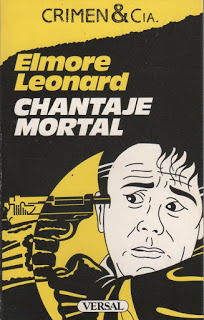 I must have read this book before... Way back when I first fell in love with Elmore Leonard's writing.
I must have read this book before... Way back when I first fell in love with Elmore Leonard's writing. (I subsequently fell out of love with Elmore Leonard's writing, but suddenly it looks like our relationship may be in recovery...)
In any case, I could remember nothing about 52 Pick Up. And when I recently watched John Frankenheimer's movie adaptation, as striking as the film was, it did nothing to rekindle my memories of the book.
But it did prompt me to seek out a copy and read it again. I got the Penguin with the Peter Chadwick cover photo, the nicest edition easily available...
And reading it was sheer pleasure.
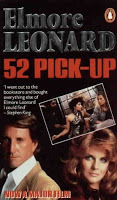 It's odd how similar the book is to the film yet, so vastly different.
It's odd how similar the book is to the film yet, so vastly different.It's essentially the story of a blackmail plot gone badly wrong. It goes wrong, as the perpetrators themselves observe, because "we picked the wrong guy."
The wrong guy is Harry Mitchell, known as Mitch, who runs an engineering company. His background in engineering is important because it enables him to provide the explosive retribution that concludes both book and film.
But that really is the least interesting aspect of the story, and of Mitch's character.
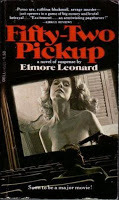 A review in the front of my copy of 52 Pick Up mentions Elmore Leonard in the same breath as John D. MacDonald, one of my great writing heroes...
A review in the front of my copy of 52 Pick Up mentions Elmore Leonard in the same breath as John D. MacDonald, one of my great writing heroes...In fact it mentions him in the same breath as Dashiell Hammett and Raymond Chandler and John D. MacDonald. Stellar company but, on the basis of this novel, not inaccurate.
Leonard's writing is terse, colloquial and eloquent. He handles agonising suspense and brutal action adroitly.
But his great strength is characterisation. In this story Mitch is up against a triumvirate of extortionists, Leo Frank and Alan Raimi, and the unforgettable Bobby Shy.
 Leo runs a sleazy business where customers can take photographs of live nude girls (this is 1974) or just ogle them. He's a "fat-ass little juice head who was liable to melt with a little heat."
Leo runs a sleazy business where customers can take photographs of live nude girls (this is 1974) or just ogle them. He's a "fat-ass little juice head who was liable to melt with a little heat."
Bobby — my favourite, and no doubt everybody else's — is a "quiet, easy-moving black dude" and also a "badass... gunslinger."
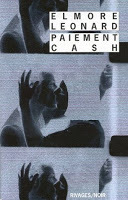 The cowboy comparison is no accident. Elmore Leonard used to write Westerns, and when we first meet Bobby he is performing an armed hold up on a bus full of tourists — "robbing the stage coach," as Bobby puts it.
The cowboy comparison is no accident. Elmore Leonard used to write Westerns, and when we first meet Bobby he is performing an armed hold up on a bus full of tourists — "robbing the stage coach," as Bobby puts it. Mitch has fallen foul of such people because he was having an affair with the beauitful young Cini, one of those live nude models, and that gave Leo the idea to blackmail Mitch, who is a respectable married man with money.
We never meet Cini in the book. She's an offstage presence when the story begins, and apparently at least a passive accomplice to this extortion plot.
But we never find out exactly how deeply she's involved, because when Mitch fails to cave in to the blackmail demands (he's the wrong guy to try this on, remember), the bad guys decide to change tack...
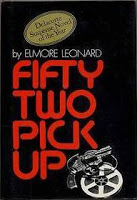 They kill Cini and convincingly threaten to frame Mitch for her murder. This presents a major problem for Mitch.
They kill Cini and convincingly threaten to frame Mitch for her murder. This presents a major problem for Mitch.But also a problem for the book. Because on the one hand Mitch never seems sufficiently upset by the death of Cini — he is supposed to have cared for her, even loved her.
On the other hand, Leo and Alan and Bobby seemed to have escalated to first degree murder, without any certainty of reward for it, remarkably easily.
However, as we gradually begin to realise what a psycho Alan is, and how casual Bobby is about killing, Cini's death becomes a lot more convincing.
 Still the problem remains that Cini is a cypher, an undeveloped character, and her death doesn't have enough of an impact on our hero.
Still the problem remains that Cini is a cypher, an undeveloped character, and her death doesn't have enough of an impact on our hero.That, and the slightly grandiose explosive conclusion, are the only flaws for me in this deeply satisfying crime novel. I haven't enjoyed reading anything so much for months.
Most notably, there is considerable joy in watching the bad guys realise that Mitch is not "the kind of straight-A stiff he had looked at first."In fact his response to these shadowy blackmailers is to "Find out who they are. Then kick ass." Indeed it turns out Mitch is an ex fighter pilot.
 When his wife Barbara warns him, "They've already killed someone," Mitch replies, "So have I. With six machine guns."
When his wife Barbara warns him, "They've already killed someone," Mitch replies, "So have I. With six machine guns."Barbara is an excellent character in the novel, much more three-dimensional and well realised than in the movie. At one point she says she's just "Trying to grow old gracefully. Like everyone else."
Full marks to Leonard for his touching and convincing depiction of a good marriage. One which survives not only Mitch's infidelity but the blackmail and murder that ensue.
And when Alan the creepy psychopath decides to target Barbara, we genuinely care about what happens to her.
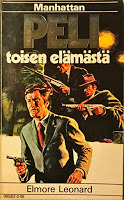 But throughout the book, it's the trio of crooks who hold centre stage and command our attention:
But throughout the book, it's the trio of crooks who hold centre stage and command our attention:Alan Raimi, a rivetting portrait of a murderous monster who just loves creating mayhem and who has ambitions not just to show smutty movies but to become a director and make "a good hard-core porno but done well, with style; not just a dirty movie, a dirty film."
Leo Frank, the fat, soft, greed cowardly drunk who is in way too deep, and swimming with sharks, to boot.
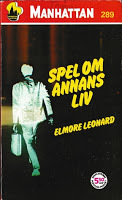 And of course Bobby Shy, a latter day cowboy outlaw snorting cocaine with a silver Little Orphan Annie spoon.
And of course Bobby Shy, a latter day cowboy outlaw snorting cocaine with a silver Little Orphan Annie spoon.And we can all sympathise with his musings about his girlfriend, the beautiful and amoral Doreen when Bobby says of her apartment, "I got half my clothes there now. I don't know where I live."
This is a beautifully observed character detail. But such incipient domesticity doesn't stop Bobby from smothering Doreen almost to death while interrogating her about Mitch — a harrowing scene in both the book and the movie.
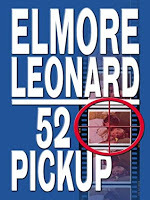 Elmore Leonard's affection for these bad guys (and girls) is evident in the way he calls them by their first names, whereas the hero is always known by his last name; even his wife calls him Mitch.
Elmore Leonard's affection for these bad guys (and girls) is evident in the way he calls them by their first names, whereas the hero is always known by his last name; even his wife calls him Mitch. (This, incidentally, is a reversal of the standard procedure in popular fiction.)
But as dangerous as Bobby and Alan are, Mitch proves to be more dangerous still, playing them off against each other and finally luring them to their doom.
I enjoyed 52 Pick Up immensely and it compells me to reassess Elmore Leonard's work.
Leonard wrote over 30 crime novels, the last one published in 2012. And I suspect I'm not entirely wrong in my impression that he went somewhat off the boil in his later career.
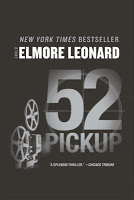 But this book is serious evidence that there are masterpieces in his back catalogue.
But this book is serious evidence that there are masterpieces in his back catalogue.(Image credits: The main picture — the gorgeous black and yellow Spanish edition — is from ABE and Chantaje Mortal means Deadly Blackmail. The Penguin cover with Bobby Shy in a stocking mask, with a photo by Peter Chadwick, is my scan of my own — now rather beloved — copy. I plan to make that Spanish one mine, too. The rest are from Good Reads, including the nicely dynamic first paperback edition (Dell 4555) of the guy in the movie theatre. I also covet that one.)
December 20, 2020
A View to a Kill by Fleming, Maibaum and Wilson
 I've always been a follower of James Bond, both in print and on screen.
I've always been a follower of James Bond, both in print and on screen. I'm writing about A View to a Kill this week because I'm discussing this film with Matt in our podcast.
And, to be honest, I nominated this particular 007 screen outing, the last to star Roger Moore, because I remembered it as being the worst in the series.
But I hadn't seen the film again since I first caught it on the big screen in Leicester Square in 1995 and it turns out I was considerably too harsh on it.
James Bond was, of course, created by novelist Ian Fleming. Fleming also posthumously contributed the title to this movie — a variant on his short story 'From a View to a Kill'.
 Other than that, it is entirely the work of two screenwriters, the veteran Richard Maibaum who had been scripting Bond since the very first movie, Dr No (1962), and Richard G. Wilson, who had been Maibaum's co-writer since For Your Eyes Only (1981).
Other than that, it is entirely the work of two screenwriters, the veteran Richard Maibaum who had been scripting Bond since the very first movie, Dr No (1962), and Richard G. Wilson, who had been Maibaum's co-writer since For Your Eyes Only (1981).A View to a Kill is very much a movie of two halves. The first part, protracted, dull and undistinguished, involves James Bond (Roger Moore) circling around billionaire bad guy Max Zorin (Christopher Walken) mostly at an event in France showcasing Zorin's thoroughbred race horses.
This includes a fight at the top of the Eiffel Tower and a car chase through Paris, but it's still dull and undistinguished. When this far from thoroughbred section finally reaches its finish line, the movie relocates to California, around San Francisco.
When this far from thoroughbred section finally reaches its finish line, the movie relocates to California, around San Francisco.And it picks up wonderfully, mostly because Stacey Sutton (Tanya Roberts of Sheena fame) is a first rate Bond girl.
For a start, she's intelligent and highly educated, a geologist who analyses earth tremors on her computer. Which is lucky because Zorin's sinister scheme is, effectively, mass murder by earthquake through fracking, with Silicon Valley the main target.
 This plot has the effect of rendering A View to a Kill, so antiquated in other respects, strangely up to date. And Stacey has some sharp lines — "If it happened at the peak of the spring tide for maximum effect..."
This plot has the effect of rendering A View to a Kill, so antiquated in other respects, strangely up to date. And Stacey has some sharp lines — "If it happened at the peak of the spring tide for maximum effect..." This is excellent and indicates both that she knows her stuff and that the writers did their research.
Stacey also has a cat. (Mercifully Maibaum and Wilson refrain from pussy jokes... even though that does seem to be the cat's name.)
 And when Bond rescues Stacey from home-invasion and intimidation by Zorin's thugs, instead of trying to immediately and remorsely bed her afterwards, he sees her safely off to sleep and then watches over the house.The next morning we find Bond dozing in a rocking chair with both a pump action shotgun and the cat in his lap — a genuinely appealing figure.
And when Bond rescues Stacey from home-invasion and intimidation by Zorin's thugs, instead of trying to immediately and remorsely bed her afterwards, he sees her safely off to sleep and then watches over the house.The next morning we find Bond dozing in a rocking chair with both a pump action shotgun and the cat in his lap — a genuinely appealing figure.Pitted against him, Walken as Zorin is a fun villain, the product of Nazi breeding science and a bloodthirsty maniac, he channels Robert De Niro when he goes full murderous psychopath.

And, at the end, as Zorin slips to his doom from the Golden Gate Bridge, he gives a little self deprecating laugh.
Zorin's girlfriend is May Day, a striking performance by model turned singer turned movie star Grace Jones.
Incredibly striking visually — at times virtually a pantomime devil — and a considerable physical screen presence, May Day is an interesting figure: combination femme fatale and bad guy's powerful enforcer, à la the steel-toothed Jaws.
 And, ultimately, Bond's ally when Zorin betrays her: "I thought that creep loved me."
And, ultimately, Bond's ally when Zorin betrays her: "I thought that creep loved me." A View to a Kill is directed by John Glen, who began with Bond as a film editor on On Her Majesty's Secret Service, and has alluring costumes by Emma Porteous.
It also possesses a major asset in the form of John Barry's music. After nearly twenty years writing soundtracks for Bond movies it wouldn't be surprising if Barry had been running out of steam — and ideas — at this point.

But his score for A View to a Kill is terrifically strong and memorable.
The main theme gives a catchy melody to the song 'Dance into the Fire', which Duran Duran fail to do justice to, and provides excellent thematic material throughout the film.
A View to a Kill isn't all good, but the bits that are, are surprisingly first rate.
I feel a little bit bad about my previous judgement...

This movie clearly is far from being the worst Bond...
To find out what that is, I would have to rewatch the whole series.
Which I might just do.
(Image credits: IMDB.)
December 13, 2020
The Infinite Hive by Rosalind Heywood
 This book is a non fiction work about the paranormal and is a sequel to Rosalind Heywood's The Sixth Sense, which I wrote about here. In that post I discussed my ambivalence to the whole notion of ESP — I feel the subject is fascinating but the evidence is not compelling.
This book is a non fiction work about the paranormal and is a sequel to Rosalind Heywood's The Sixth Sense, which I wrote about here. In that post I discussed my ambivalence to the whole notion of ESP — I feel the subject is fascinating but the evidence is not compelling.Many would disagree with me. Although he's not cited in this book (he was a forgotten man at the time it was written) it seems Alan Turing was interested in the paranormal: “the statistical evidence, at least for telepathy, is overwhelming.”
The Infinite Hive (the title is a quotation from a sermon by John Donne, alluding to the buzzing complexity of the human mind) is different from The Sixth Sense. The earlier book was a scholarly study of the subject.
 This one is a collection of personal experiences which fall into the paranormal realm. Sounds juicy? Yes, but it takes its bloody time to get going. The endless pussyfooting build-up drove me crazy.
This one is a collection of personal experiences which fall into the paranormal realm. Sounds juicy? Yes, but it takes its bloody time to get going. The endless pussyfooting build-up drove me crazy. I wanted to shout "Get on with the good stuff." But we're on page 46 and Heywood is still hedging her bets and establishing the terms of the discussion, before offering her stories of ESP.
When we do get down to these accounts, they disappointingly start with a "famous spiritualist medium of unquestioned integrity" whose spirit guide was "transparently honest."
Well, you can guess what I think of that... Or, in case you can't: I immediately questioned the integrity of the famous spiritualist, and I suspected the spirit guide was opaquely deceitful.
 Heywood's own memoir is considerably more interesting. Her experiences as a war nurse would win the respect of any reader. And I was impressed by the profound insight she got from trying mescalin: "to take my yapping little ego at all seriously is quite ridiculous."
Heywood's own memoir is considerably more interesting. Her experiences as a war nurse would win the respect of any reader. And I was impressed by the profound insight she got from trying mescalin: "to take my yapping little ego at all seriously is quite ridiculous."Indeed, Heywood is an altogether charming writer. She discusses her lifelong love of reading and says "the library had the effect on me that the smell of fish has on a kitten."
The book is full of intriguing but unverifiable anecdotes. At one end of the scale there's her son, who would routinely look up streets on a map because he knows he'll soon be asked where they are by a stranger when he goes out.
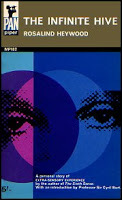 At the other is the lonely cottage she and her husband rent which contains such a malign and overwhelming sense of a hostile presence that they get the local vicar in to conduct an exorcism.
At the other is the lonely cottage she and her husband rent which contains such a malign and overwhelming sense of a hostile presence that they get the local vicar in to conduct an exorcism.Now, I feel that Heywood was an honest and intelligent woman who had some extraordinary experiences.
And I sympathise with her when she's hurt because somebody "rejects as nonsense an impression which one feels, but cannot prove to be, extra-sensory. It is as if music one heard in the distance were to be dismissed with contempt as only the wind in the trees."
Yet, I'm afraid that somebody is me. Heywood writes, "Such feebly corroborated experiences as mine are easy game for people who fear ESP."
Is that me, too? I think not. One doesn't need to fear ESP to have problems with these kind of accounts, although they remain fascinating. And frustrating.
(Image credits: The two pan editions are from Tikit. The American hardcover with a different title is from Amazon. The British hardcover is from ABE.)
December 6, 2020
The Hateful Eight by Quentin Tarantino
 The Hateful Eight, Quentin Tarantino's eighth film, appeared in 2015. It's a raw, violent, wintry western where a blizzard is effectively one of the major characters. (Tarantino compares it to the monster in a monster movie, which isolates and menaces the protagonists.)
The Hateful Eight, Quentin Tarantino's eighth film, appeared in 2015. It's a raw, violent, wintry western where a blizzard is effectively one of the major characters. (Tarantino compares it to the monster in a monster movie, which isolates and menaces the protagonists.)The film begins with a striking credit sequence, yellow text laid in dramatic contrast against the winter blue landscapes.
 And what landscapes they are. The Hateful Eight was shot using the revival of a special Panavision widescreen format that hadn't been used for 50 years (the last time was a lukewarm Charlton Heston historical adventure called Khartoum).
And what landscapes they are. The Hateful Eight was shot using the revival of a special Panavision widescreen format that hadn't been used for 50 years (the last time was a lukewarm Charlton Heston historical adventure called Khartoum).There's a documentary on the Blu-ray I watched which charts the heroic efforts by the good folks at Panavision and by The Hateful Eight's cinematographer, Tarantino regular Robert Richardson, to bring back this 70mm technology. They succeeded in a spectacular fashion.
 Ironically, releasing the movie in this deluxe format in the UK lend to a petulant spat between two cinema chains over who would have the exclusive rights to show it. (Apparently sharing was out of the question.)
Ironically, releasing the movie in this deluxe format in the UK lend to a petulant spat between two cinema chains over who would have the exclusive rights to show it. (Apparently sharing was out of the question.)The upshot was that the movie chain I subscribe to, Cineworld, sulkily refused to show this film at all. Thanks a bunch, guys.

Anyway, that's why I am only catching up with this film now, and on Blu-ray instead of the big screen.
The Hateful Eight begins with a bounty hunter tallying up the value of the corpses of the bad guys he's killed.
 This gave me déjà vu for a moment until I realised where my memory was coming from — Sergio Leone's For a Few Dollar More, which I'd recently watched.
This gave me déjà vu for a moment until I realised where my memory was coming from — Sergio Leone's For a Few Dollar More, which I'd recently watched.The bounty hunter there was Clint Eastwood. Here it is the always welcome Samuel L. Jackson as Major Marquis Warren (a nod by Tarantino to Charles Marquis Warren, a prolific writer and director of B-movie and TV westerns).
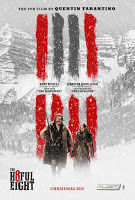 From the spaghetti western beginning, The Hateful Eight transforms swiftly into a classic Hollywood western set up — can a prisoner be safely transported to prison before they're rescued by their gang? This is the plot of 3:10 to Yuma, based on an Elmore Leonard short story.
From the spaghetti western beginning, The Hateful Eight transforms swiftly into a classic Hollywood western set up — can a prisoner be safely transported to prison before they're rescued by their gang? This is the plot of 3:10 to Yuma, based on an Elmore Leonard short story.The prisoner in this case is Daisy Domergue, played with spirit and humour by Jennifer Jason Leigh. Her captor is another bounty hunter, John Ruth, portrayed by Kurt Russell looking like Yosemite Sam in his winter plumage.
 John Ruth is another bounty hunter, though unlike the Major, his shtick is bringing in his prisoners alive, so that they hang. Hence his nickname, the Hangman.
John Ruth is another bounty hunter, though unlike the Major, his shtick is bringing in his prisoners alive, so that they hang. Hence his nickname, the Hangman.The Major joins the Hangman — who is super paranoid about Daisy being freed — on the stagecoach so he can escape the blizzard.
 Soon they are joined by another refugee from the storm, Walton Goggins as Chris Mannix. His arrival only heightens the Hangman's paranoia.
Soon they are joined by another refugee from the storm, Walton Goggins as Chris Mannix. His arrival only heightens the Hangman's paranoia.A paranoia which, by the end of the film will prove richly justified.
The motley crew on the stage coach take shelter from the burgeoning blizzard at an isolated way station, the bizarrely named Minnie's Haberdashery.
 Here they find a healthy — or, rather, unhealthy — assortment of very suspicious characters any one, or more, of whom might be in league with Daisy and looking to slit the Hunter's throat.
Here they find a healthy — or, rather, unhealthy — assortment of very suspicious characters any one, or more, of whom might be in league with Daisy and looking to slit the Hunter's throat.With our characters isolated by the storm and not knowing who to trust we are now in Agatha Christie territory — specifically And Then There Were None or The Mousetrap.
Indeed, with everyone locked in this rambling shack and the blizzard howling outside we might almost be in for a locked room murder story.

However, when violence erupts it is much more savage than that rather genteel genre ever depicted. Indeed, The Hateful Eight's final stage of evolution is into what is effectively a back-woods horror movie.
The Hateful Eight is very violent indeed. Indeed it's brutality proved a bit of a turn-off for me. I was particularly unsettled by the casual bashing of poor old Daisy Domergue.

Now, Daisy is set up as being a ruthless and pitiless killer in her own right. The problem is that we only know of this through dialogue and by inference.
We never see Daisy do anything wicked, so that makes the violence against her seem entirely unjustified.
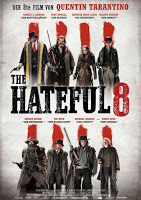 But I am an enthusiastic admirer of Quentin Tarantino and I've learned that I can't always judge his movies on my first reaction — that kind of mistake led to me wrongly dismissing the terrific Inglorious Basterds, for instance.
But I am an enthusiastic admirer of Quentin Tarantino and I've learned that I can't always judge his movies on my first reaction — that kind of mistake led to me wrongly dismissing the terrific Inglorious Basterds, for instance.So I'll watch the movie again and in the meantime just close my observations here with some of its praiseworthy aspects.
 Add captionEnnio Morricone provides a powerful score — the first time Tarantino has hired a composer instead of using music from his record collection (though there's some of that, too). Morricone's music seems to arise seamlessly out of the action and the ambient noise of the film.
Add captionEnnio Morricone provides a powerful score — the first time Tarantino has hired a composer instead of using music from his record collection (though there's some of that, too). Morricone's music seems to arise seamlessly out of the action and the ambient noise of the film. And it's always gorgeous visually thanks to the brilliance of Robert Richardson (also incidentally Oliver Stone's regular cinematographer). Even when the story is constrained to a stage coach or log cabin, it looks great. And it never feels like the vast 70mm frame is being wasted.
 There also is a typically strong and talented cast, largely consisting of Tarantino regulars. It's fascinating to see Tim Roth (as Oswaldo Mobray) initially channelling Christoph Waltz, although he goes on to add some fine toothy mannerisms of his own.
There also is a typically strong and talented cast, largely consisting of Tarantino regulars. It's fascinating to see Tim Roth (as Oswaldo Mobray) initially channelling Christoph Waltz, although he goes on to add some fine toothy mannerisms of his own.But the acting honours here really go to Walton Goggins in a superb performance where he subtly transforms his normal voice and physicality to achieve something entirely new.
This part clearly shows his growth as an actor and one can see him on a trajectory leading to this year's Them That Follow and his career-best performance as a snake-handling hill country pastor.
 The Hateful Eight is brutal, shocking and never dull. It's often very funny, and very cruel. The brutality and cruelty are absolutely deliberate, and it's certainly no accident that the first image of the film is a crudely carved and tormented looking Jesus on a wooden cross.
The Hateful Eight is brutal, shocking and never dull. It's often very funny, and very cruel. The brutality and cruelty are absolutely deliberate, and it's certainly no accident that the first image of the film is a crudely carved and tormented looking Jesus on a wooden cross.But it is also a skilfully constructed mystery and, full marks to Tarantino, you won't guess the ending.
Or soon forget it.
(Image credits: A terrific selection of posters at Imp Awards.)



